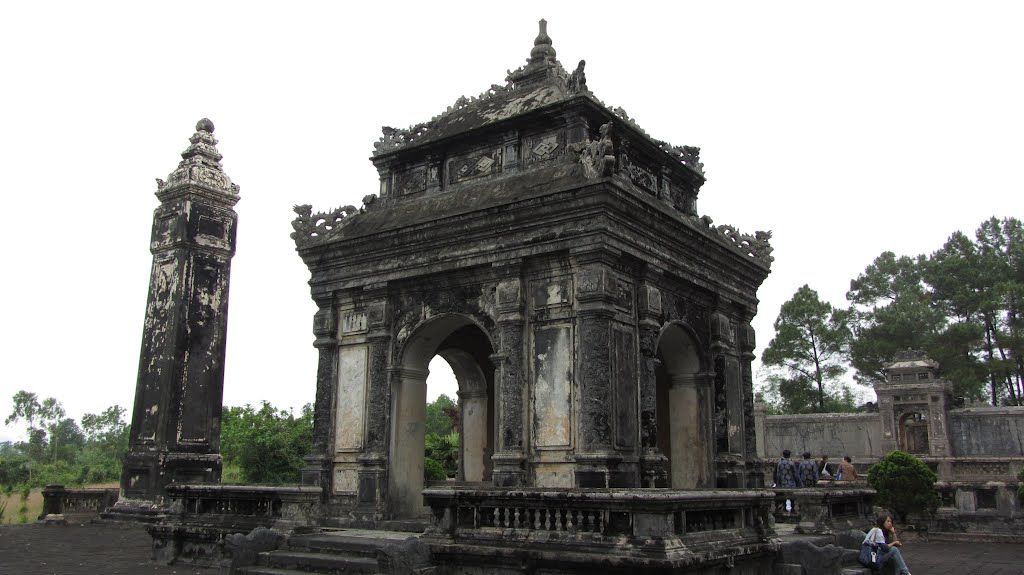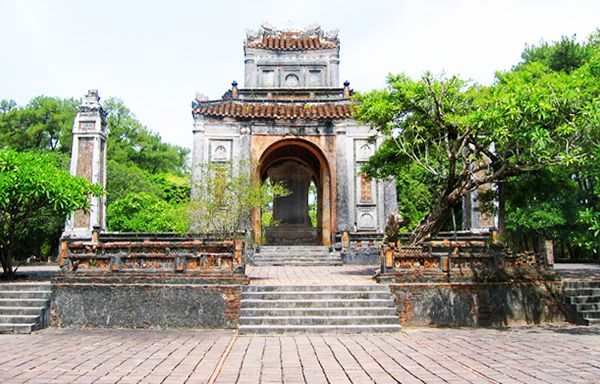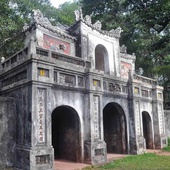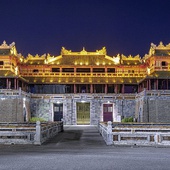Dong Khanh Tomb
The construction of Dong Khanh tomb met with many obstacles. It prolonged over 35 years and 4 kings, which saw a mix of influence in the tomb’s architecture.
Location & History
The tomb is located near Cu Si Hamlet, now known as Thuong Hai Village, within Thuy Xuan Commune in Hue City. It is situated approximately 5 kilometers from the city center. The construction of the Dong Khanh Tomb faced numerous challenges, resulting in a lengthy process that spanned over 35 years and involved four different kings.
 Photo: baoxaydung.com.vn
Photo: baoxaydung.com.vn
King Dong Khanh, who was an adopted son of King Tu Duc, ascended to the throne under the influence of French colonial authorities. Following his coronation, he commissioned the construction of a temple named Truy Tu Temple within the grounds of his father’s tomb, Kien Thai Vuong. Unfortunately, he did not anticipate his own death at the young age of 25, just three years into his reign, and thus had not prepared plans for his own tomb. After King Thanh Thai succeeded him, the nation was experiencing significant instability; hence, Dong Khanh was venerated in Truy Tu Temple, which was later renamed Ngung Hy Temple. His remains were buried simply on a hill known as "Ho Thuan Son," located 30 meters to the west of Ngung Hy Temple. The entire site is referred to as Tu Lang. The construction process faced multiple interruptions, with most of the work ultimately completed under the reign of Khai Dinh, Dong Khanh’s son, in 1917.
What To See
The complex history of its construction has resulted in a blend of architectural influences evident within this monument. A prominent feature of the site is Ngung Hy Temple, characterized by its unique triplet layout, which includes a central mansion and a smaller ancillary building, typical of the Hue Citadel’s design. The temple is furnished with traditional royal furniture and showcases intricate calligraphy. Meanwhile, Ngung Hy also marks the transition to a new artistic era, incorporating elements from both Western and Eastern cultures. Notably, the temple features 24 paintings depicting the Chinese narrative "Nhi Thap Tu Hieu," illustrating 24 examples of filial piety.
 Photo: giavethamquan.com
Photo: giavethamquan.com
Conversely, the design of the tomb area exhibits significant Western influence, reflecting in its structural peculiarities and decorative themes, as well as the choice of building materials. For example, the Stele Pavilion was constructed using concrete, tile bricks, and traditional bricks rather than stone.
How To Get There
The tomb is open year-round from 7:30 AM to 5:00 PM. Located approximately 200 meters from Tu Duc Tomb, visitors can easily reach it by bike, taxi, or motorbike.
Useful Information
- Location: Thủy Xuân Commune, Huế
- Best for: Family, Solo
- Entrance: Free
- Hours: 7:30 - 17:00
- Distance to city center: 4.5km (2.8 mi)

Tu Hieu Pagoda
In Hue - one of Vietnam's most sacred lands of Buddhism, Tu Hieu is regarded as the largest and oldest pagoda, and also a famous sightseeing spot with historical and cultural value.

Hon Chen Temple
Hon Chen Temple is situated on a lovely slope of Ngoc Tran Mountain, 10km upstream from Hue Centre. The name “Ngoc Tran'' means Pearl Bowl, originating from the bowl-shape of the mountain. That also gives the temple its name: Hon Chen.

Hue Imperial Citadel
Famously being one of Vietnam’s seven UNESCO World Heritage Sites, the Imperial City of Hue has long been a must-see attraction for tourists visiting a hidden charm of Vietnam.








